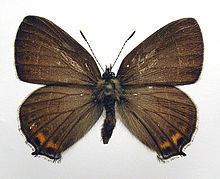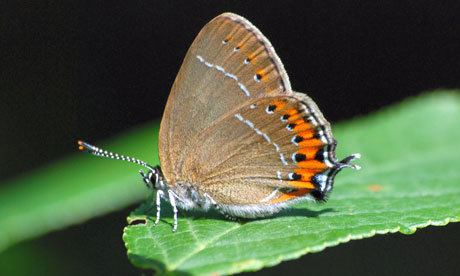Higher classification Satyrium | Scientific name Satyrium pruni Rank Species | |
 | ||
Similar Satyrium, White‑letter hairstreak, Butterflies and moths, Butterfly, Brown hairstreak | ||
Black hairstreak
Black hairstreak
Distribution

It is present in much of Europe, Russia and the Middle East.It is also present in much of Asia, Siberia and on to Korea and Japan.
Great Britain

it is rare in Great Britain and the largest breeding colony is in Ham Home-cum-Hamgreen Woods in Buckinghamshire. Historically there have been around 90 known colonies since its discovery in 1828 but there have been many, mostly unsuccessful, introductions at various locations in southern England including one in Surrey in 1952 that seemed to be successful until the habitat was destroyed. It is now one of the rarest butterflies in Great Britain.
Appearance, behaviour

Note that information on this species applies to Great Britain and some details may not be consistent with the species in other parts of its range.

This small brown butterfly is very similar to the white-letter hairstreak but the black hairstreak has a row of orange spots along the edge of the upper-side hindwing. In the female these spots also extend to the forewings. The undersides are similar to the white-letter but the white line tends to be straighter and the orange border extends onto the forewings. The most conclusive way to distinguish the two is by the row of black spots accompanying the orange band which the white-letter hairstreak never has. They spend most of their lives in the canopy or in dense scrub, feeding on honeydew, and very rarely come down to ground level.
Life cycle and foodplants
Eggs are laid singly on young blackthorn Prunus spinosa growth and it is this stage which hibernates. Although blackthorn is the main foodplant, wild plum Prunus domestica and other Prunus spp are occasionally used. The caterpillar hatches the following spring, at the end of April, just before the buds open and feeds on the flower buds. Older larvae are green and well camouflaged against the leaves on which they feed. Pupation takes place on leaves or twigs in June and the pupae are patterned black and white to mimic a bird dropping, as a defence against being eaten. The adult butterflies of this single-brood (univoltic) species are on the wing from the end of June to mid July.
